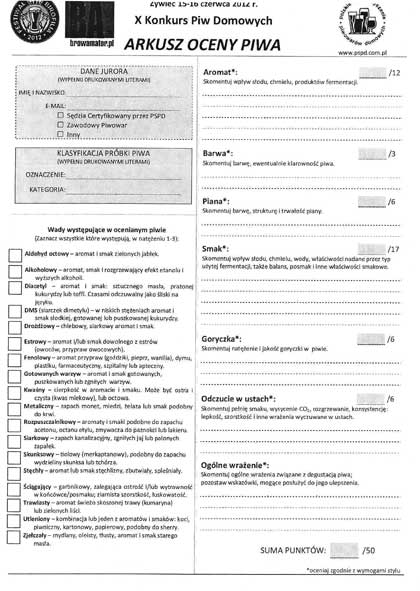
Quick disclaimer: This post won’t be an in-depth discussion about bitterness itself, IBU, quality of bitterness or something similar. I just wanted to use goryczka in a headline. Instead, this is a copy of the beer competition scoresheet used by the Polish Homebrewers Association. It is similar to a Beer Judge Certification Program (BJCP) scoresheet, but the differences are interesting.
Obviously it is in Polish. Because they are good hosts, the Polish homebrewers also provided an English version for English-speaking judges (or German speakers who also spoke English, etc.) last month during the X-th Konkurs Piw Domowych (National Homebrew Competition) held at the Zywiec Brewery.
Should you not want to toggle back and forth between the two, here’s how they compare:
| BJCP | Polish | |
| Aroma/Aromat | 12 | 12 |
| Appearance/- | 3 | – |
| Color/Barwa | – | 3 |
| Foam/Plana | – | 6 |
| Flavor/Smak | 20 | 17 |
| Mouthfeel/Odcsucie w ustach | 5 | 6 |
| Bitterness/Goryczka | – | 6 |
| Overall/Ogólne wraženie | 10 | – |
Both scoresheets list (on the left) possible flaws, but on the BJCP sheet judges simply check the boxes when those are present while in Poland they rate the intensity.
The key additions in Poland are foam (color, structure, quality, meaning volume, stability and cling) and bitterness (the intensity and quality of the bitterness).
For the record, like style guidelines these scoresheets are designed for beer competitions, not real life. Taking them outside that environment can lead to long, meaningless arguments discussions. However the influence of the BJCP sheet on the scoring matrix at RateBeer (Aroma 10, Appearance 5, Taste 10, Palate 5, Overall 20) should be obvious and the cultural impact of beer rating sites internationally cannot be understated.
They’ve got at least a few people talking about beer in a way they weren’t before. Personally, I like foam and I like bitterness. I’d be happy to see them be part of the conversation.
I always felt that 12 points is a sufficient range for most beers, especially ones that feature aroma.
I’ve always been perplexed as to what to do with beers that call for, “Little to no malt aroma” and “Hop aroma may range from none to a light”.
12 points is 20% of Score for a Light Lager. That’s a lot of wiggle room just for having no diacetyl.
ooops. Context. I’m referring to the aroma score.
Stan, this is an enormously interesting post. You’re exactly right that cultural impact of the BJCP cannot be (I’d say) overstated. It’s far more profound here at home, where the emphasis on off-flavors and the failure to carefully describe positive flavors has led to an impoverished idea about what beer should taste like.
Imagine how our understanding of beer would be different if we had the Polish chart (which though not perfect is a big improvement on the BJCP). The Poles are more interested in appearance (19% of the points), for starters–something the BJCP barely nods at. Dividing it into foam and color emphasizes the elements of appearance, too.
It would be wonderful to see a chart like you have, but with scoresheets from countries around the world.
the cultural impact of beer rating sites internationally cannot be understated.
Ah, the old “cannot for must not” – see a good discussion of this common (so don’t fret, Stan, you’re in good company) phenomenon on one of my favourite sites, Language Log, here.
That apart, interesting to see the Polish for “taste” appears to be “smak” – borrowed from German, presumably.
As for “foam” it depends on the style – English cask ale, not necessarily, Pils, yes please.
Martyn – Oops.
Jeff – I’m not sure there are any similar scoresheets. Worth looking for.
For what it’s worth, the major commercial competitions in the US do include bitterness as one of the criteria on their judge sheets.